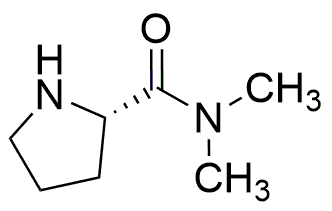L-Proline dimethylamide is widely utilized in research focused on:
- Pharmaceutical Development: This compound serves as a valuable intermediate in the synthesis of various pharmaceuticals, particularly in the creation of peptide-based drugs, enhancing their efficacy and stability.
- Biochemical Research: It is used in studies involving protein folding and enzyme activity, helping researchers understand the mechanisms of action for different biomolecules.
- Organic Synthesis: L-Proline dimethylamide acts as a chiral auxiliary in asymmetric synthesis, allowing chemists to produce enantiomerically pure compounds more efficiently than with other chiral agents.
- Agricultural Chemistry: This compound is explored for its potential in developing agrochemicals, contributing to more effective and environmentally friendly pest control solutions.
- Material Science: It is investigated for use in creating novel polymers and materials, offering unique properties that can improve product performance in various applications.
General Information
Properties
Safety and Regulations
Applications
L-Proline dimethylamide is widely utilized in research focused on:
- Pharmaceutical Development: This compound serves as a valuable intermediate in the synthesis of various pharmaceuticals, particularly in the creation of peptide-based drugs, enhancing their efficacy and stability.
- Biochemical Research: It is used in studies involving protein folding and enzyme activity, helping researchers understand the mechanisms of action for different biomolecules.
- Organic Synthesis: L-Proline dimethylamide acts as a chiral auxiliary in asymmetric synthesis, allowing chemists to produce enantiomerically pure compounds more efficiently than with other chiral agents.
- Agricultural Chemistry: This compound is explored for its potential in developing agrochemicals, contributing to more effective and environmentally friendly pest control solutions.
- Material Science: It is investigated for use in creating novel polymers and materials, offering unique properties that can improve product performance in various applications.
Documents
Safety Data Sheets (SDS)
The SDS provides comprehensive safety information on handling, storage, and disposal of the product.
Product Specification (PS)
The PS provides a comprehensive breakdown of the product’s properties, including chemical composition, physical state, purity, and storage requirements. It also details acceptable quality ranges and the product's intended applications.
Certificates of Analysis (COA)
Search for Certificates of Analysis (COA) by entering the products Lot Number. Lot and Batch Numbers can be found on a product’s label following the words ‘Lot’ or ‘Batch’.
*Catalog Number
*Lot Number
Certificates Of Origin (COO)
This COO confirms the country where the product was manufactured, and also details the materials and components used in it and whether it is derived from natural, synthetic, or other specific sources. This certificate may be required for customs, trade, and regulatory compliance.
*Catalog Number
*Lot Number
Safety Data Sheets (SDS)
The SDS provides comprehensive safety information on handling, storage, and disposal of the product.
DownloadProduct Specification (PS)
The PS provides a comprehensive breakdown of the product’s properties, including chemical composition, physical state, purity, and storage requirements. It also details acceptable quality ranges and the product's intended applications.
DownloadCertificates of Analysis (COA)
Search for Certificates of Analysis (COA) by entering the products Lot Number. Lot and Batch Numbers can be found on a product’s label following the words ‘Lot’ or ‘Batch’.
*Catalog Number
*Lot Number
Certificates Of Origin (COO)
This COO confirms the country where the product was manufactured, and also details the materials and components used in it and whether it is derived from natural, synthetic, or other specific sources. This certificate may be required for customs, trade, and regulatory compliance.


